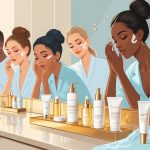Little-Known SPF Mistakes Quietly Raising Your Risk This Week
I swear, if I see one more person squeeze a pea-sized blob of SPF 15 onto their nose and strut around like they’ve cracked the code, I’m gonna lose it. The whole “just enough” sunscreen thing? Not even close. And then there’s the crowd that acts like SPF 50 is some magical forcefield—slap it on once, toss the bottle in the bag, and never think about it again. Meanwhile, their ears and the backs of their hands? Totally exposed. Oh, and let’s not even start on the under-chin zone. No one ever remembers that. The real SPF fails aren’t just about forgetting to use it—they’re about all the weird stuff nobody talks about. Skipping “hidden” spots, squeezing the last drops out of a crusty old tube, or assuming you’re set for the day with a single application. Dr. Kentley (who, honestly, sounds exhausted by this topic) keeps reminding us: SPF 50 isn’t a day-long pass. You sweat, you swim, you wipe your face, and suddenly you’re just as vulnerable as the guy who forgot his sunscreen at home. There’s a reason those protection times are so short.
If I got paid every time someone told me, “My moisturizer has SPF, so I’m fine for office days,” I’d probably have enough to buy a lifetime supply of hats. I mean, I’ve skipped my neck, eyelids, and ears more times than I want to admit. UV rays don’t care about your intentions—they bounce off water, concrete, car windows, your phone, whatever. Supposedly, you’re supposed to check sunscreen expiration dates, but how? I sniffed one once. Regretted it immediately. Smelled like sadness and old bananas.
“Broad-spectrum” gets tossed around like it means something special, but Dr. Lee just rolled his eyes and said, “If it doesn’t block UVA and UVB, you’re wasting your time.” Even “waterproof” stuff? Rub it off with a towel or jump in the pool and—poof—gone, no matter what the label promised. And this endless debate: chemical or mineral sunscreen? No one mentions that the real issue is reapplying, which is boring and sticky, so we all just… don’t. That’s why these SPF mistakes stick around. Science says one thing, but honestly, who’s timing their poolside reapplications?
Understanding the Basics of SPF
SPF numbers are a weird science experiment, not some magic shield you can feel working. I used to think “broad-spectrum” was just a marketing trick—turns out, I was wrong, and my skin paid for it. I mean, how are you supposed to know if you’re actually protected after a ten-minute walk? You can’t. It’s all just… hope and vibes.
What Does SPF Actually Mean?
Grabbed my sunscreen tube this morning—no, not expired, but what does SPF 30 even mean? Supposedly, it stands for sun protection factor, and the number is just a math thing. SPF 30 lets about 1/30th of UVB rays reach your skin, but only if you use enough, and nobody does. Dermatologists keep saying SPF 15 lets in 1/15th, 30 is 1/30th, blah blah, but “blocks 97%” is only in the lab. Out here? You’re never blocking 100%. It’s like chasing a unicorn.
People buy higher numbers thinking they’re invincible. Reapplying? Yeah, sure. Who’s actually doing that at a BBQ? There’s always someone waving around SPF 70 like it’s a superhero cape, but honestly, it’s just optimism on sale.
Types of UV Rays and Their Effects
So, you think you’re careful, but the sun finds a way. There’s UVA and UVB. Everyone’s scared of sunburn (that’s UVB), but UVA is the sneaky one—goes deeper, messes up collagen, speeds up wrinkles, and yeah, can cause cancer. They both suck, just in different ways. I always imagine UVA as the long con—quiet, patient, and then one day you wake up with crepey skin and wonder what happened.
Most people forget that UV rays bounce off pretty much everything—water, sand, snow, concrete, even your phone screen. Ears, eyelids, under the chin—those spots get fried, and you don’t notice until it’s too late. I’ve seen so many pink eyelids in spring, and nobody believes it’s from the sun unless they’re literally at the beach.
Broad-Spectrum Protection Explained
I used to think “broad-spectrum” was just a fancy label. Nope. It means the stuff actually blocks both UVA and UVB. If you skip it, you’re only dodging sunburn, not the aging or DNA damage. Dermatologists (and every single skin care panel ever) go on and on about broad-spectrum, and for once, they’re not exaggerating. FDA even says these are the only ones that really do the job. Forgetting your neck or hands? That’s how you end up with weird tan lines and, eventually, regrets. There’s a reason every guide screams about broad-spectrum. My worst burns? Always on the days I skipped SPF on “nobody sees this” spots, thinking a hat was enough. (Spoiler: it wasn’t.)
Common SPF Mistakes Most People Make
Every summer, I forget everything I’m supposed to know about sunscreen. SPF numbers, all those times I got burned, the rules about reapplying—out the window. You’d think it’d be easy, but nope. The mistakes just sneak in, and suddenly I’m one shade away from lobster.
Underapplying Sunscreen
Here’s what drives me crazy: people think a tiny dab of sunscreen is enough. I see it all the time—one swipe, then off they go, convinced SPF 50 means they’re invincible. Not even close.
Dermatologists say people use about half the amount they’re supposed to. Real talk? For your whole body, you need about an ounce—a shot glass full. Try doing that before work and not getting it on your shirt. If you skimp, you’re basically wearing SPF 10 or less. Everyone says it: if you don’t cover everything evenly, you get weird streaks and sunburn. There’s nothing glamorous about it, just sticky hands and regret.



